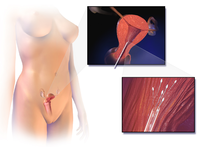
Photo from wikipedia
Background Identification of relevant in vivo biomarkers for fertility remains a challenge for the livestock industry. Concentrations of the small peptide hormone oxytocin (OXT), involved in male reproductive function and… Click to show full abstract
Background Identification of relevant in vivo biomarkers for fertility remains a challenge for the livestock industry. Concentrations of the small peptide hormone oxytocin (OXT), involved in male reproductive function and present in the seminal plasma (SP) of several species could be a robust one. This study characterized concentrations of SP-OXT in ejaculates from boars used in artificial insemination (AI) programs aiming to evaluate its relationship with sperm quality variables and in vivo fertility of their liquid-stored AI-semen. Seminal OXT concentrations (ng/mL) were measured in 169 ejaculates from 61 boars of the Duroc, Pietrain, Landrace and Large White breeds using a direct competitive immunoassay test based on AlphaLISA® technology. Ejaculate (ejaculate volume, sperm concentration, total sperm count) and sperm parameters (motility, viability, intracellular generation of reactive oxygen species, plasma membrane fluidity) were assessed at 0 h and 72 h in AI-semen samples stored at 17 °C. In vivo fertility included only 18 Large White and Landrace boars whose AI-semen was used to inseminated > 100 sows and evaluated both farrowing rate and litter size of 3,167 sows. Results The results showed that SP-OXT differed between boars and between ejaculates within boar (P < 0.05) but not between breeds (Duroc, Pietrain, Landrace and Large White). Ejaculates with higher SP-OXT concentration/mL (hierarchically grouped; P < 0.001) had larger volume and came from younger boars (P < 0.05). Ejaculates of boars showing positive farrowing rate deviation exhibited higher (P < 0.05) SP-OXT concentration/mL than those with negative farrowing rate deviation. Conclusion The SP concentrations of OXT are boar, ejaculate and age dependent, and positively related with ejaculate volume and farrowing rates of liquid-stored semen AI-doses. Supplementary Information The online version contains supplementary material available at 10.1186/s40104-021-00620-z.
Journal Title: Journal of Animal Science and Biotechnology
Year Published: 2021
Link to full text (if available)
Share on Social Media: Sign Up to like & get
recommendations!